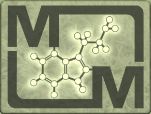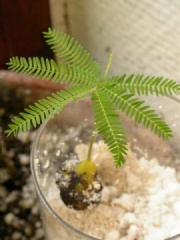 |
MAGISKA MOLEKYLERS WIKI |
Yopo
Inneh├źller: Fr├żmst Bufotenin samt sm├ź m├żngder DMT och 5-MeO-DMT
Inneh├źll
Generell information
I gamla spanska texter fr├źn Columbus tid n├żmns ett snus kallat cohoba som indianerna anv├żnder. Effekterna av snuset var att "Indianerna f├Črlorar medvetandet och blir som fulla". Fram tills 1967 trodde man att det var tobak som var ingrediensen i snuset. W. E. Safford identifierade den till slut som Piptadenia peregrina, idag mer k├żnd som Anadenanthera peregrina. Safford kunde g├Čra denna identifieringen efter att ha uppt├żckt bruket av yopo bland indianerna runt Orinocofloden i Venezuela.
Numera ├żr det bara ett f├źtal indianstammar i just detta omr├źdet som anv├żnder denna formen av hallucinogent snus, drogen har tidigare haft st├Črre spridning i Sydamerika och Karibien. Man kan hitta A. Pergerina i Colombia, Ecuador, Peru, Bolivia samt norra Argentina.
Bl├Čtlagda fr├Čn mals ner till en pasta tillsammans med n├źgonting alkaliskt, traditionellt pulveriserade sn├żckor eller aska fr├źn v├żxter. Pastan torkas sedan och mortlas till pulver. L├żs mer om tillredningen l├żngre ner. Pulvret snusas eller bl├źses med hj├żlp av n├źgon annan in i n├żsan genom ett r├Čr. L├żs mer om tillredningen l├żngre ner.Det p├źst├źs ├żven finnas om indianstammar som krossar fr├Čna och r├Čker dom tillsammans med tobak, men det finns f├Čr mycket fetter i fr├Čna att det blir en hemsk r├Čk.
V├żxter som anv├żnds till Yopo
- Anadenanthera peregrina Yopo, Cohoba
- Anadenanthera colubrina Yopo, Cebil,
- Anadenanthera macrocarpa
- Anadenanthera excelsa
Om inneh├źllet
| ŌĆ£ | Considerable chemical work on Anadenanthera shows conclusively and consistently that bufotenine is the only significant alkaloid in mature seeds of both species used for snuffs (Torres & Repke 1996; de Smet & Rivier 1987; Sdvio Nunes et al. 1987; Rend6n 1984; Schultes et al. 1977; Yamasato 1972; Chagnon, Le Quesne & Cook 1971; Fellows & Bell 1971; Holmstedt & Lindgren 1967; Paris, Saint-Firmin & Etchepare 1967; lacobucci & Rdveda 1964; Giesbrecht 1960; Pachter, Zacharias & Ribeiro 1959; Alvares Pereira 1957; Fish, Johnson & Horning 1955; Stromberg 1954).
Up to 7.4% bufotenine has been found in seeds of A. peregrina var. peregrina, only 0.04% 5-MeO-DMT and 0.16% DMT; 12.4% bufotenine in A. colubrina var. Cebil, with but 0.06% and traces of both tryptamines, respectively. Seven studies of 15 samples of Anadenanthera snuffs likewise showed bufotenine to be the only tryptamine present in significant amounts (up to 2.67%, with only traces of 5-MeO-DMT and DMT) (Torres et al. 1991; de Smet & Rivier 1985; Schultes et al. 1977; De Budowski et al. 1974; Holmstedt & Lindgren 1967; MariniBettblo, Delle Monache & Biocca 1964; Fish, Johnson & Horning 1955). |
ŌĆØ |
Tillredning
| ŌĆ£ | Piaroa Yopo Preparation
As part of ongoing ethnographic fieldwork expedition, I lived for six months in 2000 with Jose-Luis Diaz, a highly respected Piaroa shaman of the middle Parguaza river.During this time i was able to witness the preparation of yopo on two occasions. The same process was followed each time and i was assured that the same process was and had been followed for all Piaroa shamans, although some were said to make stronger yopo than others.Jose-Luis maintained that potency depended partly on the quality of the ingredients used and partly on the shaman's timing and technique of blending ingredients. Yopo seeds (Nua nu) are collected by the Piaroa from established tree stands as thet come to maturation from october to february. Suficient seeds are harvested at this tme to enable Piaroa shamans to prepare fresh yopo throughout the year, as necessity requires. Seeds from different areas are considered to be of various strengths and carry different names. Seeds derived from the grasslands of the lower Parguaza River( referred to as wekmanua) are recognised as the strongest in the entire area of Piaroa occupation and have attracted the interest of at least the neighbouring Hiwi and Piapoco. A Piaroa shaman might collect from one or more stands of trees and give or trade seeds he has collected from certain stands with shamans living and collecting in other areas so that a diversity of seeds is kept at any given time. The current practice of yopo seed trade is consistent with historical accounts of long distance treks undertaken by Piaroa ritual specialiststo obtain powerful yopo or seeds sourced from the mature trees of the grasslands of the lower parguaza River (Mansutti Rodriguez 1986). On the day yopo is to be made, a Piaroa shaman will begin by collecting the bark of a particular tree, valued for the fineness and whiteness of the resultant ash. The Piaroa use four diffrent trees for this purpose , depending on regional availability. A tree refered to in Piaroa as nonyero is the prefferred wood of the Parguaza River shamans.Piaroa shamans maintain that the ash of this tree preserves the strength of yopo for the greatest duration. For the Piaroa it is imperative that the strips of bark to be converted to ash appear intact and of good constitution when removed from the tree.Seitz (1979)noted a similar insistence on the use of only barks of impeccable physical constitution in those selected for their ash in the Waika preparation of epena. The bark of the firts five trees Jose-luis located in the forest near his house were 'too deteriorated' to be deemed adequate for use. The bark , removed with a machete had come off in stringy and insufficeintly large strips.Jose Luis assured me that the larger the sheets of bark that obe is able to peel away , the higher the quality of the resultant ash .Piaroa insistence on the selection of large , Healthy strips of bark for ash from specific trees is echoed in Seitz's decription (1979) of the Waika preparation of epena.bark is immediately cut into strips 10 to 15 centimetreswide and tied together.This bundle is suspended above a metal tray and lit from the bottom. Strips burn upwards and a white ash is collected from the tray below. While thebark is being reduced to ash, seeds are poured from various yopo tree stands are mixed in a large, purpose built mortarwith several fresh B.caapi cuttings. A. peregrina seeds and B caapi cuttings are pilverised with a heavy wooden pestle for 10-15 minutes.None of the pulverised seeds and B caapi mix can be allowed to fall on the ground while it is being reduced to paste. The piaroa regard such carelessness as a sign that the yopo maker has been poorly taught.Form and fluidity are important aspects in the yop making process. The makers'aesthetics of motion relate to the degree to which the end product takes the maker, one a smoothe voyag and the extent to which the shaman can demonstrate self-control under duress. Piaroa shamans consider the manual process of working ash into the seed/ B caapi dough, and the attainment of a particular texture, as crucial to the sucess of the resulting yopo. As Jose-luis explains "It took me three years to learn how to make yopo with my father and my grandfather. The first time i lost it. The second time i lost it. The texture wasnt right. Now i know" When the correct amount of ash has been sufficientlt massaged ino the paste it "cpmes out like butter". In incremental doses an equal amount of ash as seed and caapi mix is massaged in. The resulting dough , containing pulverised A.peregrina seeds, B caapi cuttings and ash , is worked continuously and hard in the shamans hands for 30 minutes, throughout whuch time the shaman deveops a thick sweat. When the desired texture is achieved the dough (Tsunua asi) is flattened out on a plate like a large cookieand set within a grate made of thin wooden slats to stand vertically by the side of the fire. Piaroa yopo cooks for approximately 20 minutes. Piaroa yopo preparation deviates in few but significant ways from early accounts made by humboldt and Spruce for middle orinocan tribes, and more contemporary cross- cultural accounts of its preparation. A quantity of B caapi was added to the yopo mixture on the two occassions I itnessed its preparation by Jose luis. I was assured by a further two Piaroa shamans of the parguaza river and two from the Carinagua river that B caapi was always used in the preparation of yopo. Jose luis, who had lived with the Hiwi and trained with a yanomami shaman maintained that the yopo of other tribes was far weaker than that of th piaroa.This could be attributable to the addition of B caapi in Piaroa snuff |
ŌĆØ |
Externa l├żnkar
- Ōåæ Pharmacology of Bufotenine av Jonathan Ott
- Ōåæ Snuff Synergy: Preparation, Use and Pharmacology of Yopo and Banisteriopsis Caapi Among the Piaroa of Southern Venezuela (Rodd, 2002)(Foruminl├żgg i Shaman-australis forum med inneh├źllet)
Psychotropic Plants In the Americas av Jan-├ģke Alvarsson och ├ģke Hultkrantz
Erowid Anadenanthera (Yopo) Vault
Native hallucinogenic drugs piptadenias (Anadenanthera) by Granier-Doyeux
Om bruket av hallucinogena snuser av sydamerikanskt ursprung av S. Henry Wass├®n, Medicinsk Historisk ├ģrsbok 1969
Sidan ├żndrades senast 7 mars 2015 klockan 16.34.
Den h├żr sidan har visats 19┬Ā169 g├źnger.













